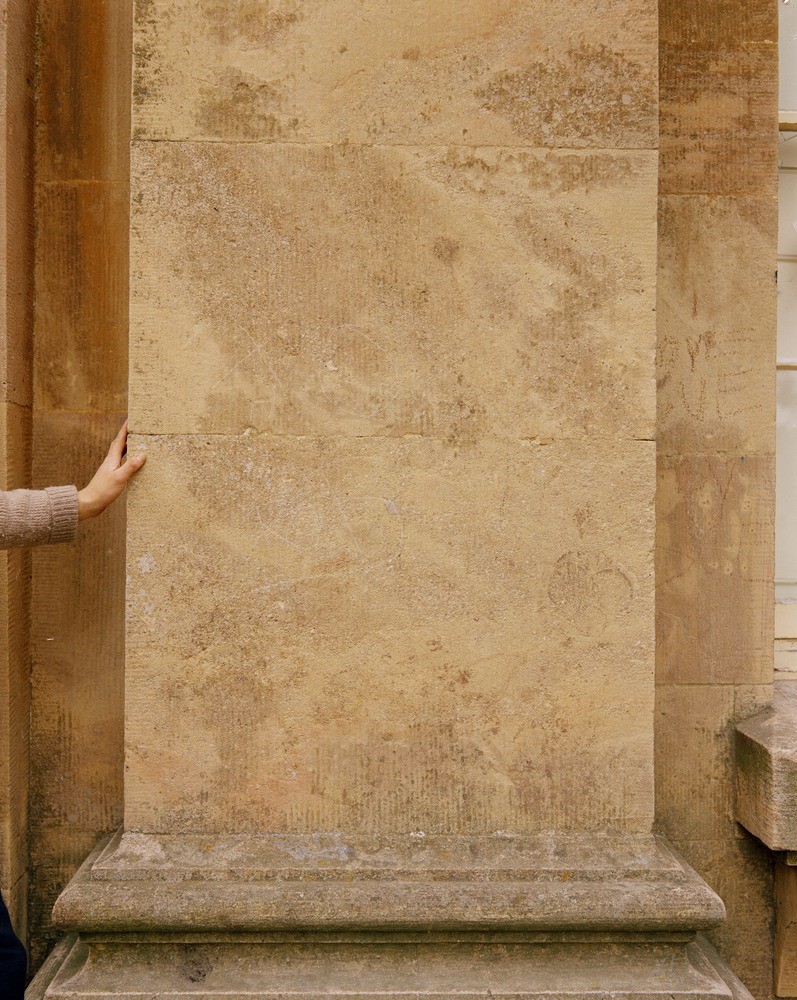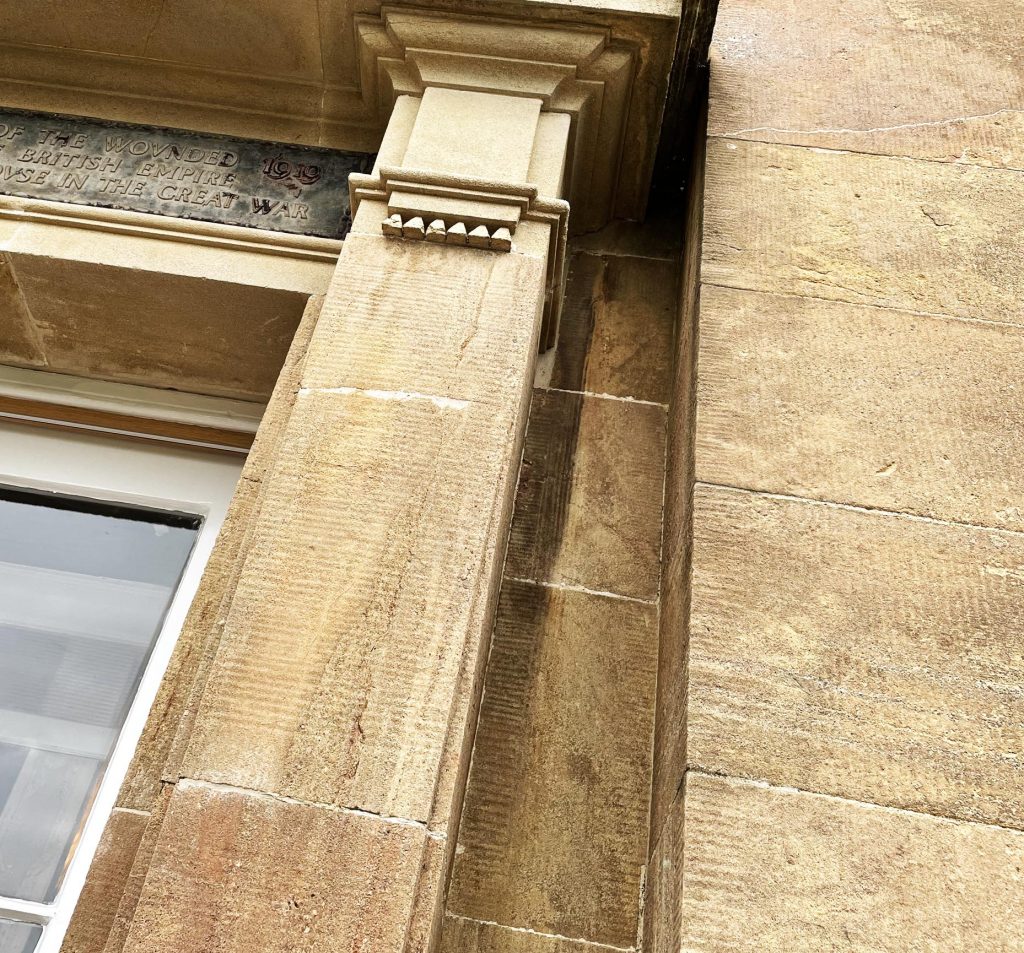One of the most distinctive aspects of Kings Weston house is the unique honey coloured stone from which it’s built. Looking closely at the blockwork you’ll notice a world of variation in its colour and composition, but also the way the original masons finished each stone. This short report hopes to focus attention on this overlooked architectural aspect.
The whole of the Kings Weston ridge is peppered with former quarries. Some are obvious, like the one fenced off below the TV transmitter, or to the north of Penpole Point; these are from the 19th and 20th Centuries and their scale is a giveaway. Others are more ancient, possibly as early as the Roman era when the nearby villa and town were built. Having been planted out with trees and landscaped in the Georgian ere these are less visible. The extent of the quarrying is most obvious using Lidar data, that shows the land without the distractions of trees and buildings.
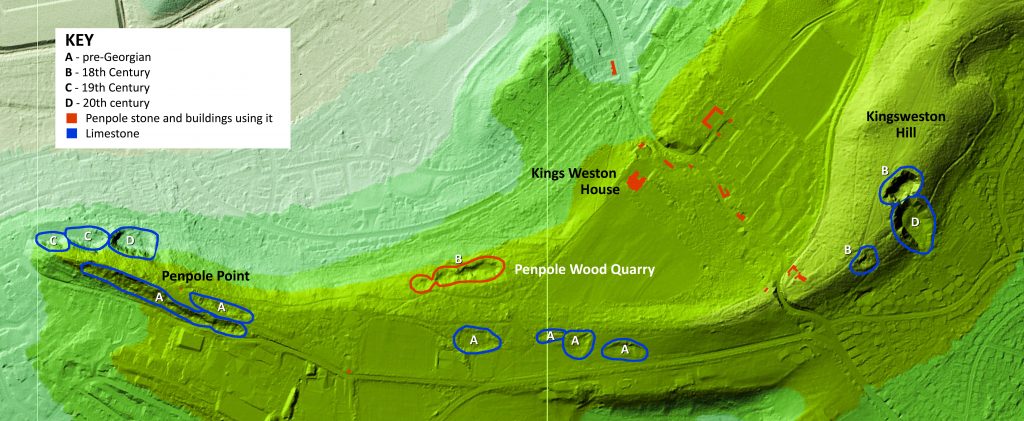
Dig anywhere along the south side of the park and you’ll soon hit greyish limestone, like that in the Avon Gorge. Once quarried it’s best used in rubble walls. But the stone Kings Weston’s built of is the more distinctive Penpole Stone. As its name suggests, Penpole Stone is found exclusively along the north side of Penpole Wood. It’s a hard and resistant ochre coloured stone with pink and red marbling, a mixture of compressed grit, clay, and glittering quartz occlusions, called Dolomitic Conglomerate. At over 200 million years old it’s certainly the most ancient thing you’ll find on the estate!
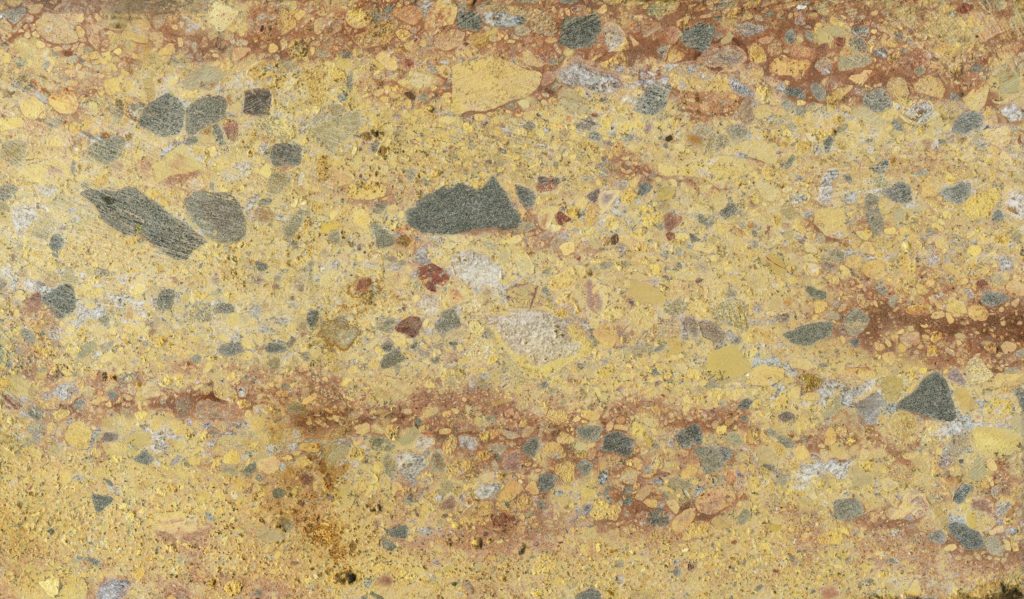
When the builders of the house were looking for materials they needn’t have looked far for a strong and durable material. The proximity of the Penpole source to the house must also have been a bonus. Other mansions in the 18th Century had to pay large sums to source and transport suitable stone, particularly if they sought the harmonious smooth ashlar finish then desirable for classical buildings. Others, for example Stoke Park, accepted cheaper rubble stone, but rendered and painted it to cover up its aesthetic shortfalls. Kings Weston benefitted not just from good stone nearby, but also one that gave its house such an attractive colour.
The site of the quarry was defined by the most appropriate stone for the job. At Penpole that location remains as an obvious woodland landmark, a long deep cut into the side of the wood that follows the line of the ridge. It was later planted as a rustic garden to reincorporate it into the landscaped parkland.
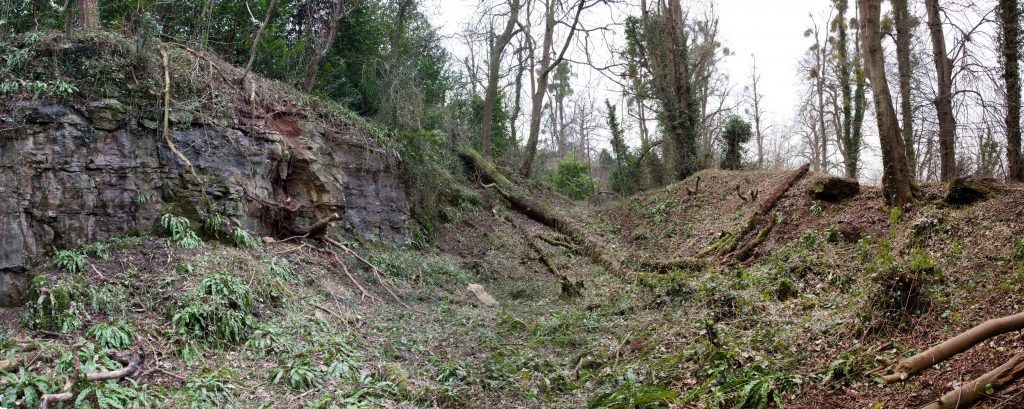
Whether the stone was the suggestion of Kings Weston’s owner, Edward Southwell, or advised by the masons he employed it would have needed to be approved of by the architect, Sir John Vanbrugh, as fit for his work. In a 1716 letter to the Duchess of Marlborough Vanbrugh names a “Mr Townsend (who did Mr Southwells’ masonry)” as the man responsible. This was probably George Townsend, master mason of Bristol, and capable architect in his own right.
In April 1712 Southwell arrived at the building site being prepared for his new house and noted “Upwards of 60 men preparing stones and digging the foundation of the new house”. One can imagine the activity at the Penpole Quarry in this work, the cutting of the stone from the quarry face, its shaping, and transportation the short distance along the ridge to where it was needed. The quantity of stone required for the construction is indicated, in part, by the scale of the excavation, though it should be noted that much of the irregular nature of the material would have been inappropriate for fine cutting, used as infill, or discarded.
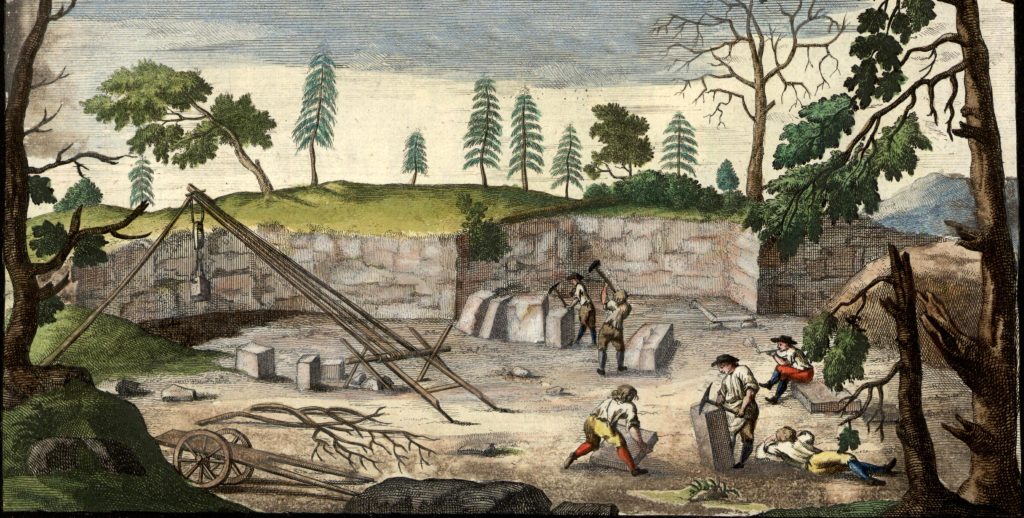
If you look at the outer walls of the house today you can see how large some of the blocks were. Some are colossal and must weigh more than a ton each. Particularly large are the single stacked blocks needed to give each of the front columns a regular appearance all the way up, and the vast shelving window cills Vanbrugh must have enjoyed drawing an exaggerated effect from. Each of these were cut and finished by hand; with such a hard stone it must have been particularly laborious.
If you look closer again you’ll spot something else; each stone is treated individually with regular ridged patterning, and a narrow grooved border in the same finish. Preparing a stone requires several stages. A roughhewn block needs to be dressed several times to get a perfectly smooth block, using different tools for each successive dressing. Here at Kings Weston the blocks have not been given the perfect smooth finish, and instead a clawed bolster, a type of wide headed chisel with teeth, used to give an intentionally grooved texture. Rather than being evidence of cutting corners the finish is deliberate and controlled, the surface of each individual block carefully articulated. This was perhaps to give a veneer of antiquity to the finished monument, or exaggerate the massiveness of the architecture so its character contributed to the “Castle air” that Vanbrugh desired of his buildings.
By September 1713 Southwell the house was so advanced that Southwell wrote that “by the end of next month I may have discharged my regiment of outside people”. However, masons work continued until 1716 Later the same stone went into building other buildings around the estate. In line with their status large blocks went into the ornamental garden buildings like the Echo and Penpole Lodge, whilst and the looser rubble went into other estate buildings like Kingsweston Inn and the cottages on Kings Weston Lane.
The facades of the house will reveal that Penpole stone, whilst predominating, was not the only material used architecturally. Being hard and unyielding it was not suitable for the finer ornamental work. The column capitals, pediment and cornices, urns and other intricate details were executed in softer, finer-grained, buff limestone, possibly from Dundry, south of Bristol. The difference in stone colour and texture is obvious once you notice it. Rather than being a poor match the subtle difference appears to have been used architecturally to emphasise the most civilising classical elements of the Enlightenment design, a deliberate contrast to the background rustic aesthetic.
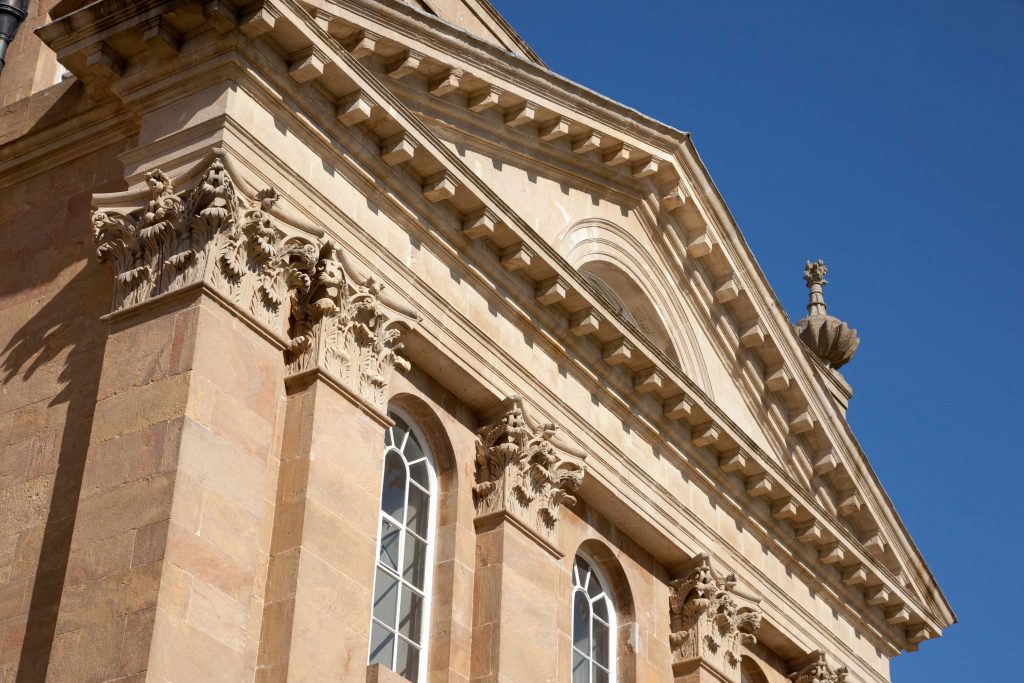
The use of specific stone finishes for aesthetic effect is seen again in the “Back Front”, at the rear of the house. This is intentionally the most ruggedly handled of the four great facades. Here, with its massive forms, turreted corner towers, arched windows, and oversized keystones, Vanbrugh’s castle keep medievalism is at its most developed. To add to the effect the use of stone changes. The massive single blocks of the other facades makes way for smaller blocks, with greater variety in size, and with irregular courses. Abandoned too is the regularity and order of the neatly tooled stonework; Instead the blocks are deliberately rough faced. The Penpole Wood quarry would produce plenty of other large blocks for later buildings on the estate, so the effect here is intentional, rather than the result of a dwindling supply of good stone.
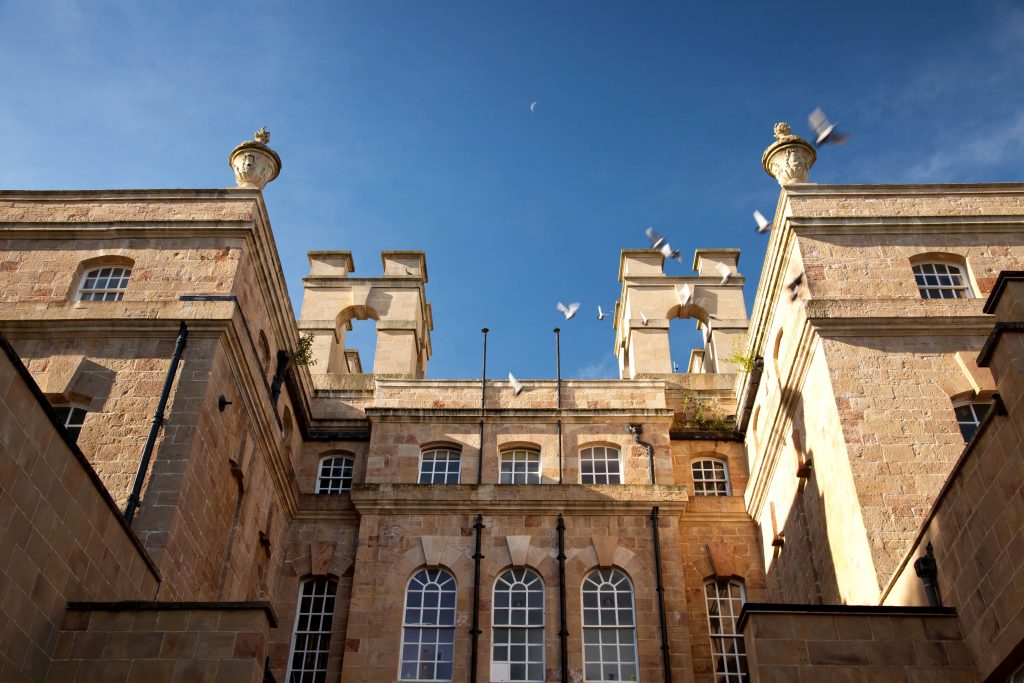
Other stone was also required to serve particular purposes. Marble was imported from Ireland for fireplaces designed to impress. Hardwearing pennant stone was brought in for steps and flagstones. This was sailed across the Severn from the Forest of Dean with surprising ease, prompting Vanbrugh to write, in a letter to the Duchess of Marlborough, who was then scrutinising her architect’s work at Blenheim Palace:
”I writ to him (Southwell) and his steward both to get an exact amount of the charge of his steps, both stone carriage and work; and the account they send me is this. The steps he has are not from Ross, where my Lord Dukes came from, but out of the Forrest from whence the carriage is so easy to Mr Southwells’ that he says they must needs cost much more to Gloucester from Ross”
Kings Weston had, by this time, become a showcase of the sort of work Vanbrugh was keen for his clients to inspect. The economy with which it had been achieved and the architectural effect would both have been features he was eager to promote. From some of Vanbrugh’s letters the Duchess had clearly been impressed when she’d visited.
“I am very glad that your Grace is pleased with Mr Southwell’s House; it being the sort of building I endeavour to bring people to who are disposed to ask my advice: Tis certain his work has been cheap and a great deal of it tolerably well”
Though, not all the mason’s work met Vanbrugh’s standards, and he pointed out to the Duchess:
“The steps in Mr Southwell’s garden are of the same stone that is us’d at Blenheim, but it cannot be had anything so cheap” “they must be better wrought and set both than Mr Southwell’s are; some of his steps being abominable.”
Perhaps we should not be surprised that these steps were replaced when the house was remodelled a generation later!


